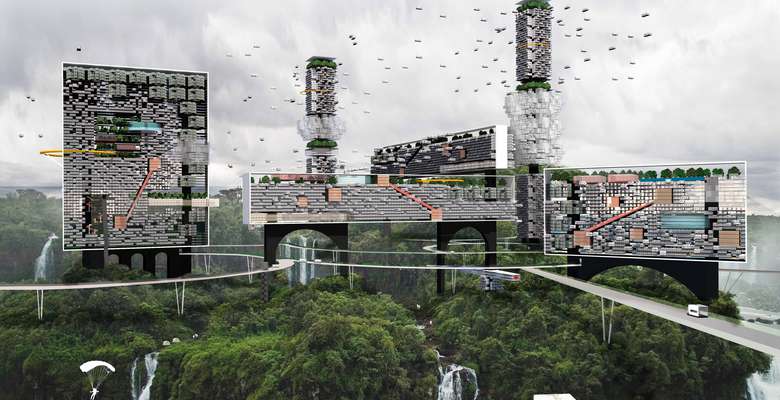Building Tomorrow: The Rise of Sustainable Construction Techniques
Introduction: In an era where environmental consciousness is paramount, the construction industry stands at a crossroads. With the global population surging and urbanization accelerating, the demand for infrastructure is higher than ever. However, traditional construction methods often come at a significant cost to the environment, contributing to pollution, resource depletion, and habitat destruction. In response, a paradigm shift is underway towards sustainable construction techniques, ushering in a new era of eco-friendly building practices that prioritize environmental stewardship without compromising on functionality or aesthetics.

The Imperative for Sustainable Construction: The need for sustainable construction has never been more urgent. As the world grapples with the challenges of climate change and resource scarcity, the built environment emerges as a key battleground in the fight for sustainability. Traditional construction methods, characterized by high energy consumption, waste generation, and carbon emissions, are no longer viable in a world striving for carbon neutrality and ecological balance. Sustainable construction offers a way forward, providing innovative solutions to minimize environmental impact while meeting the growing demand for infrastructure.
Key Principles of Sustainable Construction: At its core, sustainable construction is guided by principles aimed at reducing the environmental footprint of buildings throughout their lifecycle. These principles encompass various aspects, including:
- Energy Efficiency: Sustainable buildings are designed to optimize energy use, employing strategies such as passive solar design, high-performance insulation, and energy-efficient appliances to minimize energy consumption and reduce greenhouse gas emissions.
- Material Selection: From recycled steel and reclaimed wood to eco-friendly insulation and low-VOC paints, sustainable construction prioritizes the use of environmentally friendly materials that minimize resource depletion and pollution while promoting circular economy principles.
- Water Conservation: Sustainable buildings integrate water-saving technologies such as low-flow fixtures, rainwater harvesting systems, and graywater recycling to minimize water consumption and alleviate pressure on freshwater resources.
- Site Management: Sustainable construction practices extend beyond the building itself to encompass site management strategies that minimize habitat disruption, preserve biodiversity, and mitigate erosion and runoff through techniques such as green infrastructure and native landscaping.
- Lifecycle Assessment: A holistic approach to sustainability involves conducting lifecycle assessments to evaluate the environmental impact of a building from cradle to grave, identifying opportunities for improvement and optimization at every stage of its lifespan.
Innovative Sustainable Construction Techniques: The rise of sustainable construction has spurred a wave of innovation, leading to the development of cutting-edge techniques and technologies aimed at revolutionizing the way we build. Some notable examples include:
- Prefabrication and Modular Construction: Prefabrication allows for the off-site fabrication of building components in a controlled environment, reducing waste, minimizing construction time, and improving quality control. Modular construction takes this a step further by assembling pre-made modules on-site, offering greater flexibility and scalability while reducing environmental impact.
- Green Building Certifications: Initiatives such as LEED (Leadership in Energy and Environmental Design) and BREEAM (Building Research Establishment Environmental Assessment Method) provide frameworks for assessing and certifying the sustainability performance of buildings, driving industry-wide adoption of green building practices and standards.
- Passive House Design: Passive house design employs principles of energy efficiency, insulation, and airtightness to minimize the need for mechanical heating and cooling, resulting in ultra-low energy buildings that maintain comfortable indoor temperatures year-round with minimal energy input.
- Biomimicry: Drawing inspiration from nature, biomimetic design seeks to emulate biological processes and systems to create buildings that are not only sustainable but also resilient, adaptive, and responsive to their environment. Examples include biomorphic facades, self-healing materials, and natural ventilation systems modeled after termite mounds and tree branches.
Benefits of Sustainable Construction: The adoption of sustainable construction techniques offers a myriad of benefits, both environmental and economic. By reducing energy consumption, minimizing waste, and conserving resources, sustainable buildings help mitigate climate change, protect ecosystems, and promote human health and well-being. Moreover, sustainable construction has been shown to yield long-term cost savings through lower utility bills, reduced maintenance costs, and enhanced asset value, making it an attractive investment for developers, owners, and occupants alike.
Challenges and Opportunities: Despite the progress made in advancing sustainable construction, significant challenges remain. Cost considerations, regulatory barriers, and a lack of awareness and education continue to hinder widespread adoption. However, these challenges also present opportunities for innovation, collaboration, and leadership within the construction industry and beyond. By leveraging technology, fostering partnerships, and prioritizing sustainability in decision-making, stakeholders can overcome barriers and drive meaningful change towards a more sustainable built environment.
Conclusion: The rise of sustainable construction techniques marks a pivotal moment in the evolution of the construction industry. As the world faces pressing environmental challenges, the imperative to build more sustainably has never been clearer. By embracing principles of energy efficiency, material stewardship, and environmental responsibility, the construction industry has the power to not only reduce its environmental footprint but also shape a more resilient, equitable, and sustainable future for generations to come. Building tomorrow starts today, and sustainable construction is the blueprint for a brighter tomorrow.
…
